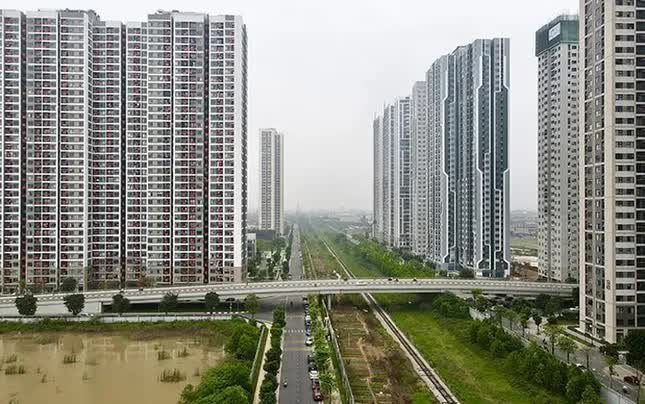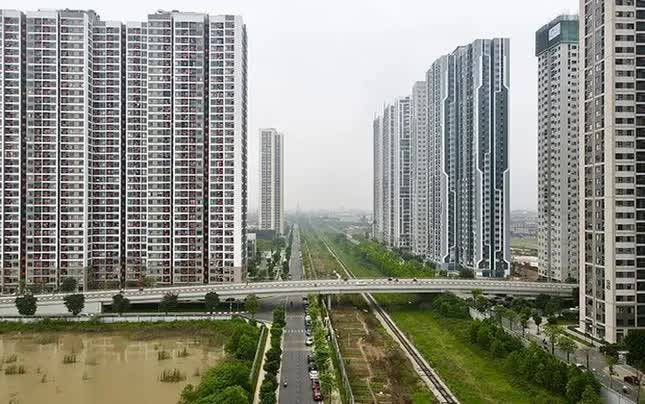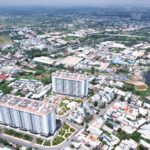Surging Capital Investment in Real Estate
In recent times, there has been a significant surge in capital investment in Vietnam’s real estate market. This is evident from the various favorable loan packages offered, targeting first-time home buyers and social housing projects, with the expectation of boosting liquidity in the market.
As of the end of 2024, the total outstanding loans for the real estate sector reached approximately 3.2 quadrillion VND, accounting for nearly 21% of the economy’s total outstanding debt. Notably, loans for real estate business activities increased by a substantial 18%, and loans for housing needs rose by 6.5%.
Interestingly, foreign direct investment (FDI) also shows signs of returning to the market. In the first four months of this year, FDI registered in real estate reached 1.5 billion USD, equivalent to 26.9% of the country’s total registered FDI. This figure highlights the confidence of foreign investors in the market’s recovery potential.
Mr. Nguyen Quoc Anh, Deputy General Director of PropertyGuru Vietnam, assessed that the market is currently pinning high hopes on the policy of loosening credit for real estate purchases. According to a survey conducted by Batdongsan.com.vn in the first quarter of 2025, 67.1% of brokers expected positive outcomes from the “policy of loosening credit for real estate purchases.” Additionally, 47.9% of brokers anticipated benefits from “reducing taxes and transaction fees for real estate,” while 43.4% hoped for “expediting legal progress.” With a projected credit growth of up to 16% and continuing downward trends in real estate loan interest rates, the market outlook appears positive.

Strong credit flows into real estate in recent times (Photo: Nhu Y)
Dr. Can Van Luc, Chief Economist at BIDV Bank, emphasized that the market is entering a phase of “restructuring demand and capital sources.” According to Mr. Luc, real estate businesses must change their approach to survive. They should focus on developing segments with actual demand, such as social housing and mid-range apartments, instead of solely pursuing upscale projects that may have limited access to credit.
Catering to the needs of genuine homebuyers not only enhances sales potential but also facilitates easier access to bank loans, as financial institutions tend to prioritize projects with practical value and lower risk.
Caution with Financial Leverage
Economic expert Nguyen Tri Hieu highlighted that financial leverage is a common tool in real estate investment, enabling investors to amplify their profits. However, he cautioned against the excessive use of leverage due to its inherent serious risks.
Many investors borrow up to 70-80% or even more, expecting to sell or rent quickly to cover loan interests. However, the market is not always favorable, and any delays in sales or rentals, coupled with unexpected expenses, can push investors into negative cash flow territory, exacerbating interest rate pressures and potentially leading to financial plan failures.
During periods of low-interest rates, bank loans might seem ideal. Nevertheless, as rates begin to climb, as witnessed in the post-pandemic cycle across numerous countries, borrowing costs surge, eroding profits entirely. For floating-rate loans, even a 1-2% increase can result in monthly payments soaring by tens of millions of dong.
“There is no guarantee that real estate prices will always increase,” warned Mr. Hieu. “In certain phases, especially after the market peaks, prices may stagnate or plummet. In such scenarios, the value of mortgaged assets might depreciate compared to outstanding debt, leading to negative equity, where investors not only fail to make a profit but also end up with debts exceeding the actual value of their assets.”
According to Mr. Hieu, apart from market factors, investors also contend with risks stemming from government policies, such as tightening credit for real estate, altering land laws, or imposing ownership taxes. These factors can significantly impact the exploitation and liquidity of assets. Loosened real estate credit does not equate to wide-open investment opportunities. In the context of a gradually recovering market, prudence and sound strategies are the keys to success for both businesses and individual investors.
The Ultimate Expansion: Unveiling the Transformational Power of Conic Boulevard
With a strategic location at the gateway to Ho Chi Minh City’s west, Conic Boulevard in Binh Chanh District is poised for a significant breakthrough. This prime position is about to witness a remarkable transformation, thanks to the ongoing development of key transportation infrastructure projects.
Vung Tau: Construction Begins on Coastal Urban Area Featuring One of the Largest Water Parks in South-Eastern Vietnam
On the afternoon of May 16, Sun Group Corporation commenced construction on the urban area project on Ba Thang Hai Street, in wards 10 and 11 of Vung Tau City. This milestone marks the journey of crafting an international-standard urban complex of living, resort, and entertainment, elevating the coastal city of Vung Tau.
Unlocking the Golden Potential: Will Binh Duong Attract Another Tech Giant?
This leading global enterprise is planning to expand its investment operations in Vietnam. With a strong presence already established in the country, the company is now looking to further strengthen its position and tap into the vibrant and burgeoning Vietnamese market. This expansion underscores the company’s commitment to driving growth and creating long-term value, not just for itself but also for the local economy and community. Details of the investment plan are yet to be unveiled, but the company assures that it will bring about significant developments and exciting opportunities for all stakeholders involved.
“Brokerage Firm Offers 50 Billion Margin Credit Line with 8% Interest Rate to Support Investors”
Celebrating its 3rd anniversary, VPBank launches an exclusive privilege for its VIP customers with a limit of up to 50 billion VND and competitive interest rates. This policy boasts transparent procedures, empowering customers to take charge of their investments and seize opportunities.
High-Speed North-South Rail: Aiming for $22 Billion in Revenue from Land and Advertising
“The proposed high-speed rail link between the North and the South has the potential to revolutionize land value and development. Experts believe that the key to unlocking this potential lies in adopting a transit-oriented development (TOD) approach. By focusing on TOD, the expected revenue from land exploitation in these areas, as well as commercial exploitation of the high-speed rail link, could reach a staggering 22 billion USD.”





















